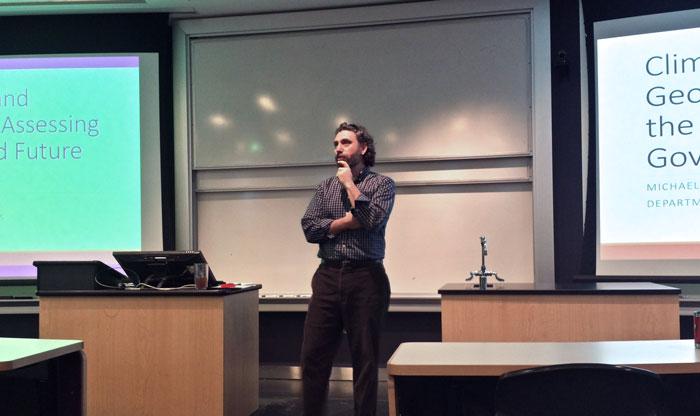Plan A Isn’t Working (But Would Plan B?)

Michael Beevers, assistant professor of environmental studies, discusses the issues surrounding geoengineering at a recent Rush Hour event. Photo by Tony Moore.
To combat climate change, technology employed on a planetary scale may be coming, says Michael Beevers
by Tony Moore
We’ve had decades of efforts in the U.S. and other developed nations targeting a reduction in greenhouse-gas emissions. We’ve been awash in international environmental agreements, aggressive campaigns and efforts to attack the problem from a behavioral standpoint and ongoing analyses, research and governance.
But it’s just not working.
“There's a sense that there's been a failure,” said Michael Beevers, assistant professor of environmental studies, who recently gave a Rush Hour talk on an emerging approach to combating climate change. “In fact, greenhouse-gas emissions are on the rise as we speak. Perhaps Plan A isn't working.”
When Plan A is focused chiefly on efforts to reduce greenhouse gases, what is Plan B? To some, it’s geoengineering.
“We've got lots of popular books starting to come out about geoengineering and whether that can help us address climate change,” said Beevers, who also spoke about geoengineering in March at the Convention of the International Studies Association in Toronto. “It’s in the opinion pages of newspapers, in articles and in academic journals; we're starting to see more and more about geoengineering.”
So what is geoengineering?
Geoengineering is any deliberate, large-scale manipulation of, or intervention in, the workings of the Earth’s climate system deployed in an effort to stop the march of global warming. More than 50 geoengineering schemes have been identified, but Beevers noted that scientists and engineers tend to focus on two: carbon dioxide removal (CDR) and solar radiation management (SRM).
CDR aims to remove carbon dioxide from the atmosphere by mechanically extracting it. SRM would reflect sunlight away from the Earth to counteract climate-change effects through techniques such as injecting salt particles into the sky to whiten clouds and make them more reflective. It sounds like science fiction, and maybe it is, for now. But even if geoengineering can become a workable reality, an uphill battle awaits regarding its use.
“The technology is obviously speculative, but there have been some small experiments going on,” Beevers said. “And these have been pretty contentious. Early geoengineering experiments [one of which involves a 10,000-square-kilometer artificial-plankton bloom that will absorb carbon dioxide and then sink to the bottom of the ocean] likely violate existing international environmental laws.”
Other issues loom
Since geoengineering amounts to altering the Earth’s climate, in countries vulnerable to climate change, national-security issues could arise if it’s deployed by another country or other entity.
“It could be an entrepreneur. It could be a single group. It could be corporations,” Beevers said. “It could be a predatory state or a state that's kind of a rogue state that feels threatened by climate change.” And if this isn’t enough to worry about, many environmentalists fear that if the world turns to geoengineering, boots-on-the-ground approaches to stifling climate change—those that involve governmental, corporate and personal responsibility—will be abandoned.
For now, geoengineering is off on the horizon, but it may just be that the way people talk about it shapes its realization, if it ever, in fact, comes to bear.
“In 10 years, I think it'll be something you all know about,” Beevers said. “We're going to see people—groups of scientists, entrepreneurs, students, activists, engineers, policy-makers, you name it—trying to serve as brokers of knowledge, to set the narrative. Future geoengineering discourses are being written right now.”
Learn more
- Department of Environmental Science & Environmental Studies
- Michael Beevers: Focus on Faculty
- Latest News
Published December 5, 2014